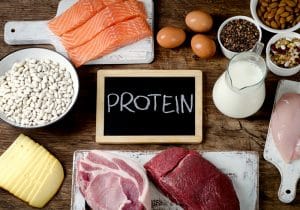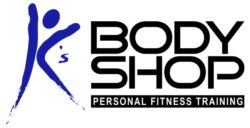
Diving into the critical role of protein for mid-life and older men and women, especially those aiming to shed body fat and bolster muscle and bone strength, is like exploring a crucial piece of a puzzle for their overall health. Protein isn’t just a building block for muscles; it’s the foundation of a well-rounded diet that fuels metabolic processes, repairs tissues, and supports bone health.
Role of Protein
Here’s a sample of important functions of protein:
- Muscle Maintenance and Growth: As we age, we naturally start to lose muscle mass, a condition known as sarcopenia. Your body begins gradually losing muscle starting around the age of 30, speeding up especially for those not actively engaging in resistance training. This loss accelerates significantly during menopause. Protein steps in as the critical resource for helping to maintain or grow muscle. It provides the amino acids necessary to repair and grow muscle fibers, especially after exercises like weight lifting or strength training. For mid-life women and older adults who might be fighting muscle loss, a protein-rich diet can help keep the muscles strong and functional.
- Bone Health: It’s not all about the muscles; bones are in the conversation too. Protein plays a supporting role in bone maintenance by aiding in the absorption of calcium and promoting bone formation and strength. Think of it as the scaffolding that helps keep the bone structure resilient against fractures, which becomes increasingly important as we age and the risk for osteoporosis climbs. Bone loss is again accelerated in women during menopause, but can affect everyone.
- Fat Loss: Here’s where protein truly shines for those looking to lose that stubborn menopause belly fat. Protein is satiating, meaning it keeps you feeling full longer. This can naturally lead to eating fewer calories without the battle of hunger pangs. Plus, the body expends more energy (burns more calories) digesting protein compared to fats and carbohydrates. It’s like revving up your metabolism. This increased calorie burn can help in shedding body fat when combined with a slight caloric deficit.
- Metabolic Health: A diet high in quality protein can also help stabilize blood sugar levels. By slowing the absorption of sugar during meals, protein helps prevent spikes in blood glucose, which can be particularly beneficial for anyone experiencing insulin sensitivity. This is one of many issues that arise for mid-life women during and after menopause.
Sources of Dietary Protein
For mid-life and older adults aiming to support muscle and bone health, lose body fat, and maintain overall vitality, diversifying protein sources is key. Getting enough of the amino acid leucine is also important. Here’s a rundown of high-quality protein sources, covering both animal and plant-based options:
Animal-Based Protein Sources
- Chicken Breast: Lean and high in protein, it’s a staple for building muscle without the high fat content found in darker poultry meat.
- Turkey: Similar to chicken, turkey is lean and packed with high-quality protein, making it excellent for muscle maintenance.
- Fish: Especially fatty fish like salmon, mackerel, and sardines, which are not only high in protein but also rich in omega-3 fatty acids, beneficial for heart and brain health.
- Eggs: A versatile and affordable source of high-quality protein that also provides essential amino acids, vitamins, and minerals.
- Greek Yogurt: Packed with protein and probiotics, it’s great for muscle health and digestive wellness.
- Cottage Cheese: Low in fat and high in protein, it’s excellent for satiety and muscle repair.
- Lean Beef: Rich in protein, iron, and vitamin B12, which are crucial for energy and muscle maintenance. Opt for grass-fed varieties when possible for higher omega-3 content.
Plant-Based Protein Sources
- Lentils: A powerhouse of not just protein, but also fiber, iron, and folate, making them great for heart health and energy levels.
- Chickpeas: Versatile and packed with protein, fiber, and minerals. They can be used in salads, soups, and hummus.
- Quinoa: A complete protein containing all nine essential amino acids, plus it’s gluten-free and rich in fiber.
- Tofu and Tempeh: Made from soybeans, they’re excellent plant-based proteins that can be used in a wide range of dishes, from stir-fries to salads.
- Black Beans: High in protein and fiber, they’re great for digestive health and can be used in numerous dishes.
- Edamame: Young soybeans that are a tasty, protein-rich snack or addition to meals.
- Nuts and Seeds: Almonds, chia seeds, flaxseeds, and hemp seeds are not only good protein sources but also rich in healthy fats and fiber.
Incorporate a variety of these protein sources into your diet to help ensure you get the broad range of nutrients your body needs to function optimally, support muscle and bone health, and aid in fat loss. Mixing animal and plant sources, if your dietary preferences allow, can make meals more interesting and nutritionally balanced.
How Much Dietary Protein Per Day?
The recommended daily protein intake for mid-life or older adults can vary based on several factors, including activity level, overall health, and specific fitness goals. However, general guidelines can provide a starting point for most individuals.
For adults, the current general recommendation is 0.8 grams of protein per kilogram of body weight per day. This is basically the minimum amount to avoid deficiency in a sedentary person. But for older adults and those engaged in regular exercise, especially resistance training or aiming for fat loss while preserving muscle mass, the needs can increase.
For Mid-Life and Older Adults:
- Active Adults and Those Engaging in Regular Exercise: The International Society of Sports Nutrition recommends between 1.4 to 2.0 grams of protein per kilogram of body weight for most exercising individuals. This increased amount supports muscle repair, growth, and overall recovery from exercise. Adults over age 65 or those with higher muscle mass goals should strive for the higher end of the range to combat age-related muscle loss (sarcopenia) and support bone health..
- Those with Higher Muscle Mass Goals: Higher protein intakes (2.3-3.1 grams protein/kg of body weight per day) may be needed to maximize the retention of lean body mass in those who have been doing consistent strength training, especially during periods where they are cutting calories in an attempt to lose fat.
Practical Example:
Let’s say you’re a 65-year-old woman who weighs 150 pounds. If you’re moderately active and looking to maintain muscle mass, you might aim for the middle range. Athletic individuals should aim for the higher end of the spectrum:
- Minimum Daily Protein Target: 68 kg x 1.4 g/kg = 95.2 grams
- For muscle mass maintenance or growth: 68 kg x 2.0 g/kg = 136 grams
- For an older athlete who has been doing years of consistent training: 68 kg x 2.5 g/kg = 170 grams
Some very recent research suggests at least 100 grams per day for any adult, no matter their size or activity level.
It’s also worth noting that protein needs should be met through a balanced diet that includes a variety of sources, as mentioned earlier, to ensure a comprehensive intake of essential amino acids and other nutrients.
Important Considerations:
- Distribute Protein Intake: Encourage consuming protein throughout the day across all meals to maximize muscle protein synthesis.
- Adjust Based on Individual Needs: These guidelines are a starting point. Adjustments may be necessary based on health status, dietary preferences, and specific goals.
- Consult with Healthcare Providers: For anyone with specific health conditions, consulting with a healthcare provider or a dietitian is crucial to tailor dietary protein intake appropriately.
As you can see, the role of protein is critical for good health. Getting enough lean dietary protein every day can be a challenge for some people, but it’s even more important as we get older.
Need a place to start? Try a complimentary 5-day email course about protein and how to plan balanced meals. The sign up form is at the bottom of this page.
References
Deer, R. R., & Volpi, E. (2015). Protein intake and muscle function in older adults. Current opinion in clinical nutrition and metabolic care, 18(3), 248–253. https://doi.org/10.1097/MCO.0000000000000162
Gaffney-Stomberg, E., Insogna, K. L., Rodriguez, N. R., & Kerstetter, J. E. (2009). Increasing dietary protein requirements in elderly people for optimal muscle and bone health. Journal of the American Geriatrics Society, 57(6), 1073–1079. https://doi.org/10.1111/j.1532-5415.2009.02285.x
Jäger, R., Kerksick, C. M., Campbell, B. I., Cribb, P. J., Wells, S. D., Skwiat, T. M., Purpura, M., Ziegenfuss, T. N., Ferrando, A. A., Arent, S. M., Smith-Ryan, A. E., Stout, J. R., Arciero, P. J., Ormsbee, M. J., Taylor, L. W., Wilborn, C. D., Kalman, D. S., Kreider, R. B., Willoughby, D. S., Hoffman, J. R., … Antonio, J. (2017). International Society of Sports Nutrition Position Stand: protein and exercise. Journal of the International Society of Sports Nutrition, 14, 20. https://doi.org/10.1186/s12970-017-0177-8
Landi, F., Calvani, R., Tosato, M., Martone, A. M., Ortolani, E., Savera, G., D’Angelo, E., Sisto, A., & Marzetti, E. (2016). Protein Intake and Muscle Health in Old Age: From Biological Plausibility to Clinical Evidence. Nutrients, 8(5), 295. https://doi.org/10.3390/nu8050295
Rondanelli, M., Nichetti, M., Peroni, G., Faliva, M. A., Naso, M., Gasparri, C., Perna, S., Oberto, L., Di Paolo, E., Riva, A., Petrangolini, G., Guerreschi, G., & Tartara, A. (2021). Where to Find Leucine in Food and How to Feed Elderly With Sarcopenia in Order to Counteract Loss of Muscle Mass: Practical Advice. Frontiers in nutrition, 7, 622391. https://doi.org/10.3389/fnut.2020.622391
Wolfe R. R. (2012). The role of dietary protein in optimizing muscle mass, function and health outcomes in older individuals. The British journal of nutrition, 108 Suppl 2, S88–S93. https://doi.org/10.1017/S0007114512002590
Resources
